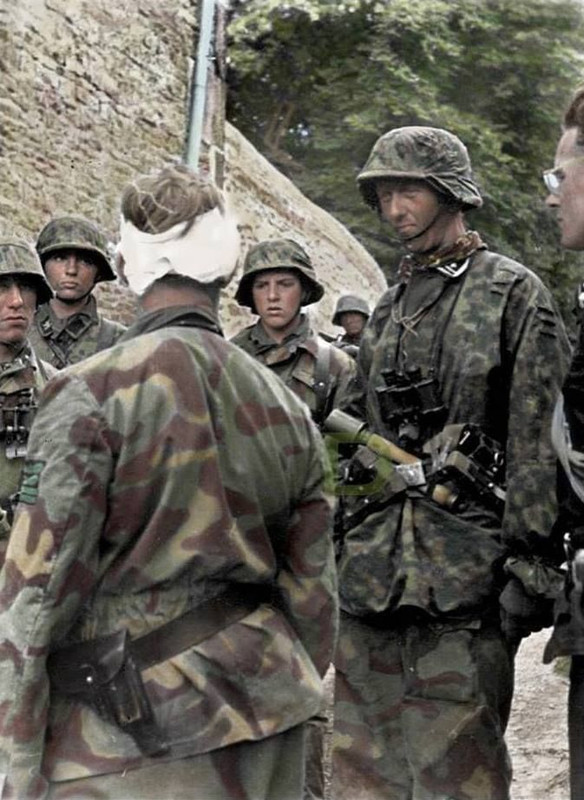
SS-Obersturmbannführer Max Wünsche (with the bandaged head), Rgt. Komm. of SS-PzRgt 12 visiting survivors of III.ZUG 15./25 SS PzG. Rgt. at Rots, Normandy on June 9, 1944.

SS-Sturmann Otto Funk also at Rots
#1 SS-Obersturmbannführer Max Wünsche (with the bandaged head), Rgt. Komm. of SS-PzRgt 12 visiting survivors of III.ZUG 15./25 SS PzG. Rgt. at Rots, Normandy on June 9, 1944.
#2 SS-Sturmann Otto Funk also at Rots
Partly seen on the right side of image #1 is SS-Hauptsturmführer Rudolf von Ribbentrop, 3. Kompanie, I./SS-PzRgt 12, son of German foreign minister von Ribbentrop.
On the left is thought to be Unterscharführer Peter Koslowski on the far right is Hauptscharführer Wilhelm Boigk, that is SS-Sturmmann Otto Funk at the back but #2 and #4 are unknown.
At around 0900 hours on the morning of 9 June, the 3rd Company of SS-Panzer-Regiment 12 rumbled through Rots towards la Villeneuve on the Caen-Bayeux highway. They were ordered to assault Norrey with the support of a small number of infantry from SS-Panzergrenadier-Regiment 25.
The attack was to be in conjunction with infantry attack from the I Battalion of SS-Panzergrenadier-Regiment 26 south of the village.
Just after noon on 9 June, Twelve Panthers fanned out in a single line at a right angle to the rail embankment. Approaching the village the company swung left keeping in a solid line with their fronts towards the village in anticipation of confronting the Canadian anti-tank guns.
Nine Sherman tanks from the 1st Hussars including several "Fireflys" equipped with 17 pdrs, were moving towards the front to reinforce the Reginas' position in Norrey. The majority of the Sherman tanks were navigating through the village, but one Firefly, commanded by Lt G. K. Henry, had worked his way around the village to the front where he spotted the advancing Panthers. Catastrophically for the 3rd Panzerkompanie, their swing to the left, though protecting them from the 6-pounders in Norrey, exposed their flanks to Lt Henry at not more than 1000 metres distance. The Canadian tank opened fire hitting the tank nearest the rail-line first. Lt Henry fired five shots and knocked out five Panthers. A sixth was accounted for by another “C” squadron tank.
The crews from the burning Panthers along with their supporting infantry retreated back to an underpass where Canadian artillery began to pound the area inflicting even more casualties.
Max Wünsche died 1995 aged 80
Rudolf von Ribbentrop born 1921 - still alive aged 94
Wilhelm Boigk KIA July 4 1944
Otto Funk died 2011 aged 85
